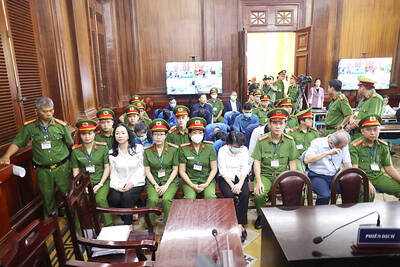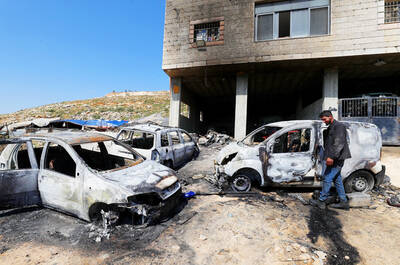Spacewalking astronauts on Sunday equipped the International Space Station with the first in a series of powerful new solar panels, overcoming suit problems and other obstacles with muscle and persistence.
It took two spacewalks for French astronaut Thomas Pesquet and NASA astronaut Shane Kimbrough to install and unfurl the panel to its full 19m in length.
The solar wing unrolled like a carpet once the final set of bolts was released, relying solely on pent-up energy.

Photo: AFP/ NASA handout
The slow, but steady extension took 10 minutes, with station cameras providing live TV views.
“It is beautiful,” Pesquet said.
“Well done, both of you,” mission control replied once the operation was complete. “That was great to see.”
As the six-and-a-half-hour spacewalk concluded, Kimbrough, who has three children, wished “Happy Father’s Day” to all the flight controller dads.
“Thanks for working with us on a Sunday,” he said.
The astronauts started Sunday’s spacewalk picking up where they left off on Wednesday last week, when a string of problems prevented them from unrolling the high-tech solar panel.
“Remember: You are butterflies with biceps today,” astronaut Megan McArthur radioed from inside.
After pushing and tugging, they managed to unfold and align the solar panel so both halves were end to end, resembling a roll of paper towels.
Their shout of “woo-hoo” was met with applause at mission control.
The two had to wait until they were back on the night side of Earth — and the station’s old solar panels were no longer soaking up sunlight and generating power — before making the final power connections. Otherwise, they could have been shocked.
While awaiting darkness, the camera-and-light assembly on Kimbrough’s helmet came loose, even though he had switched to a different suit to avoid the trouble he encountered the previous time.
Pesquet did his best to secure it with wire ties, as the minutes ticked by. His effort paid off and the final step — the unfurling — went off without a hitch.
The new solar wing — with five more to come — gives the aging station a much-needed electrical boost, as demand for experiments and space tourists grows.
NASA originally allotted two spacewalks for the job — one for each solar panel being installed — but managers added a third spacewalk, given all the earlier problems.
Pesquet and Kimbrough are to go back out on Friday to complete work on the second panel delivered by Space X earlier this month.
The first pair would augment the space station’s oldest solar wings, which are degrading after 20 years of continuous operation.
SpaceX is to deliver two more pairs over the next year.
Although smaller than the originals, the new solar panels supplied by Boeing can generate considerably more power.
The station needs them if NASA hopes to keep it running for the rest of this decade, with private guests paying millions of dollars to visit.
A Russian film crew is scheduled to launch to the orbiting outpost this fall from Kazakhstan, followed by a string of rich businessmen. SpaceX is providing the rides from Cape Canaveral, Florida.
On Wednesday last week, the display control panel on Kimbrough’s suit shut down and he had to return to the air lock to reset it. Then his cooling system registered a momentary pressure spike.
Engineers are still evaluating what went wrong.
“Space is hard,” Kimbrough wrote on Twitter.

Republican US lawmakers on Friday criticized US President Joe Biden’s administration after sanctioned Chinese telecoms equipment giant Huawei unveiled a laptop this week powered by an Intel artificial intelligence (AI) chip. The US placed Huawei on a trade restriction list in 2019 for contravening Iran sanctions, part of a broader effort to hobble Beijing’s technological advances. Placement on the list means the company’s suppliers have to seek a special, difficult-to-obtain license before shipping to it. One such license, issued by then-US president Donald Trump’s administration, has allowed Intel to ship central processors to Huawei for use in laptops since 2020. China hardliners

A top Vietnamese property tycoon was on Thursday sentenced to death in one of the biggest corruption cases in history, with an estimated US$27 billion in damages. A panel of three hand-picked jurors and two judges rejected all defense arguments by Truong My Lan, chair of major developer Van Thinh Phat, who was found guilty of swindling cash from Saigon Commercial Bank (SCB) over a decade. “The defendant’s actions ... eroded people’s trust in the leadership of the [Communist] Party and state,” read the verdict at the trial in Ho Chi Minh City. After the five-week trial, 85 others were also sentenced on

‘DELUSIONAL’: Targeting the families of Hamas’ leaders would not push the group to change its position or to give up its demands for Palestinians, Ismail Haniyeh said Israeli aircraft on Wednesday killed three sons of Hamas’ top political leader in the Gaza Strip, striking high-stakes targets at a time when Israel is holding delicate ceasefire negotiations with the militant group. Hamas said four of the leader’s grandchildren were also killed. Ismail Haniyeh’s sons are among the highest-profile figures to be killed in the war so far. Israel said they were Hamas operatives, and Haniyeh accused Israel of acting in “the spirit of revenge and murder.” The deaths threatened to strain the internationally mediated ceasefire talks, which appeared to gain steam in recent days even as the sides remain far

RAMPAGE: A Palestinian man was left dead after dozens of Israeli settlers searching for a missing 14-year-old boy stormed a village in the Israeli-occupied West Bank US President Joe Biden on Friday said he expected Iran to attack Israel “sooner, rather than later” and warned Tehran not to proceed. Asked by reporters about his message to Iran, Biden simply said: “Don’t,” underscoring Washington’s commitment to defend Israel. “We are devoted to the defense of Israel. We will support Israel. We will help defend Israel and Iran will not succeed,” he said. Biden said he would not divulge secure information, but said his expectation was that an attack could come “sooner, rather than later.” Israel braced on Friday for an attack by Iran or its proxies as warnings grew of